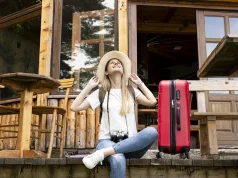
The travel industry post-covid is recovering but preferences have noticeably changed. ‘Slow travel’ – taking time to immerse yourself in the destination, engage with local cultures, and have unique experiences – is one of the breakout trends appealing to travelers seeking to incorporate wellness and sustainability into their trips.
With searches for slow travel continuing to climb steadily, Carl Friedrik, a luxury travel goods brand, surveyed over 1,000 US adults about their current vacation habits, to see how popular – and realistic – slow travel really is for Americans. [1]
To view the full results of the study, please visit: https://www.carlfriedrik.com/int/magazine/slow-travel-trend
Nine in ten Americans find slow travel appealing
Not only are three-quarters of Americans already familiar with the concept of slow travel, but after being given a definition, 94.2% would like to try slow travel or do it again.
When asked whether they would like to slow travel, 93-96% of the Gen-Z, Millennial and Gen-X respondents interviewed were keen to give it a go. Interest remained considerably high in the older age groups too, with 85% of Boomers responding that they were interested in the idea.
Half of those who had already been on a slow travel trip said that their favorite aspect of the experience was taking time to enjoy the local culture and scenery (49%). The next most popular reason was the potential for a more unique or authentic travel experience with a third (33.6%) responding that they enjoyed sightseeing at less busy or well-known sites.
In general, for those who had or had not been on a slow travel trip, the biggest appeal was meeting locals (43.1%). Other popular reasons were to immerse in the local culture (42.4%) and to take the time to fully explore at your own pace (41.5%).
Nearly a third (31%) of respondents cited environmental concerns as an incentive to adopt slow travel methods.
| What appeals to you about slow travel? | Percentage |
| Meeting local people | 43.10% |
| Immersing yourself in the culture of one place | 42.40% |
| Taking the time to fully explore a place at your own pace | 41.50% |
| Environmental concerns | 31.10% |
| Time to switch off from your job/normal life | 21.60% |
| Learning a new language | 7.90% |
The vacation activity Americans most look forward to is tasting local food and drink
Demonstrating a huge appetite for local cuisine, 54.8% of travelers expressed a desire to try local food and drinks, making food tourism the most anticipated aspect of a vacation. The next favored aspects were discovering new places (43%) and cultures (40.5%).
Although exploring new locations is a top incentive to travel, most would rather immerse themselves in one place. In fact, 89.8% prefer to stay in one spot for the whole trip — a pace of travel ideally suited to the slow and sustainable travel ethos.
Despite the popularization of the city break, almost four in ten Americans would like to immerse themselves in nature on vacation (40.6%) – a more popular pastime than simply spending time at the beach (37.4%). In fact, 90.6% of respondents said they would prefer a quieter destination.
| What do you look for when going on a vacation? | Percentage |
| Experience local food and drink | 54.80% |
| Discover new places | 43% |
| Immerse myself in nature | 40.60% |
| Discover new cultures | 40.50% |
| Spending time at the beach | 37.40% |
| Stay by the pool | 19% |
| Shopping | 17.20% |
| Nightlife | 9.90% |
Italy is the world’s most popular slow travel destination
To uncover the trending slow travel destinations, the researchers at Carl Friedrik also analyzed trending posts on Instagram to find out the most popular places to slow travel.
The majority of destinations tagged with #slowtravel on Instagram (77%) were in Europe – and only 3% of posts analyzed were US locations.
A quarter of the top posts in the study featured Italian destinations. The next most featured destinations were Spain, which was snapped 19% of the time, and Germany with 10%. Completing the top five were England and Portugal.
Although 95.3% think more people should practice slow travel, four in ten Americans like the familiarity of going to the same resort or location
Perhaps wanting to feel like they have squeezed the most out of their time and money, 88% of tourists have some form of to-do list to complete. When asked what is unappealing about slow travel the most common answers were:
- Preference for a short break (45.2%)
- Desire to visit the same place or resort/location (39.2%)
- Not enough paid time off (25%)
- Dislike concept of slow travel (14.9%)
Americans take on average just 8 vacation days per year
But the greatest obstacle to the widespread adoption of slow travel is time. Unlike in Europe, where employers are mandated to grant workers around a month of vacation days per year, in America it is up to the discretion of the employer as to how much leave to give.
Americans were most likely to plan a vacation twice a year (35.7%) or once every three months (25.7%). When they did, they were most likely to take 3 to 4 vacation days (31.2%), and the majority (79.5%) take between 3 and 7 days off.
Only 11.3% of Americans typically plan a trip for more than 8 days — meaning only one in ten Americans can truly ‘slow down’ enough for slow travel.
Remote workers take the least vacations and are the most satisfied with their time off
Onsite and office workers were the most likely to book a monthly trip (16.6%). Meanwhile, remote workers were the most likely to book a trip annually (25%), every two years, or even less frequently.
Remote workers were almost twice as likely to feel satisfied with the time off they took, whereas 93.6% of office workers said they needed more time off to properly switch off.
The survey found that eight in ten Americans experience stress whilst preparing for or returning from vacation.
Considering the fact that 76.3% of Americans feel the need to take work calls or check work emails on holiday, it’s unsurprising that 89.9% also responded that they felt they needed more time off to switch off and enjoy their time away from the desk.
Despite so many checking in on work whilst away, 42.6% of Americans found the return to work stressful. Three in ten Americans return from holiday to between 11 and 50 emails, but four in ten return to even more in their inbox.
But Americans are just as stressed – if not more – by the trip itself. The most stressful part of the holiday was traveling to and from the destination (40.5%) followed by packing (33.1%) and booking a holiday (26.7%). Only 17.1% responded that they didn’t find any aspect of vacations stressful.





